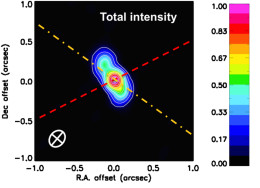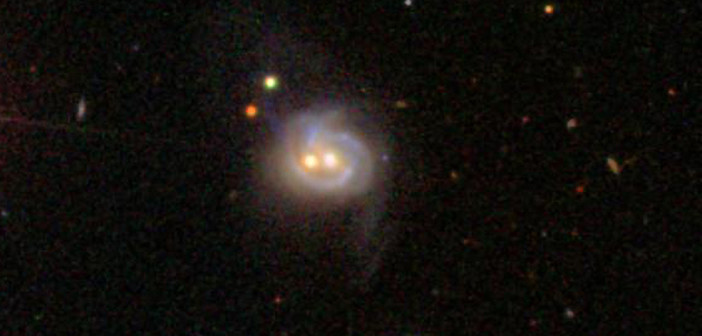Dual active galactic nuclei (AGN), an intermediary product of galaxy mergers, can give us a better understanding of what happens when two galaxies collide. But because the angular separation of the two galactic nuclei is so small at this stage, identifying these systems is very difficult. In a recent study, a team of authors proposes a new technique for confirming dual AGN candidates.
Signatures in Spectra
![Total-intensity VLA image for J1023+3243. This system is confirmed as a dual AGN; the two compact radio cores are separately identifiable here. [Müller-Sánchez et al. 2015]](https://aasnova.org/wp-content/uploads/2015/11/fig21-260x188.jpg)
Total-intensity VLA image for J1023+3243. This system is confirmed as a dual AGN; the two compact radio cores are separately identifiable here. [Müller-Sánchez et al. 2015]
But there’s a problem with using this technique to identify dual AGN: other processes also produce double-peaked narrow-line emission, mimicking the behavior of dual AGN. These processes include the rotation of ionized gas in the galactic disk, and the motion of radio jets emitted from the AGN.
A team of scientists led by Francisco Müller-Sánchez (University of Colorado Boulder) have proposed that the use of a combination of high-resolution radio observations and spatially-resolved spectroscopy could be used to discern between these possible cases.
Dual AGN or Moving Gas?
To test this method, the group examined a sample of 18 active galactic nuclei from the Sloan Digital Sky Survey. These AGN had previously been identified as candidate dual AGN with double-peaked narrow emission lines. The team obtained both optical long-slit spectroscopy and high-resolution Very Large Array observations of these AGN. They then combined this information to identify the cause of the double-peaked lines in each case.

Total-intensity VLA image for J0009–0036. This system contains a two-sided radio jet, causing the extended radio emission seen here. [Müller-Sánchez et al. 2015]
Roughly 15% are confirmed to be dual AGN. In these cases, distinctly separated radio cores are visible in the Very Large Array data, but their spectra are similar to those of single AGN.
Roughly 75% have double-peaked lines due to gas kinematics, instead. These kinematics include jets, rotating NLR regions, and wind-driven outflows. The jets are identifiable by their extended radio emission and steeper spectra, whereas the rotating NLR regions and wind-driven outflows are identifiable by their lack of additional radio cores or extended emission, and the morphology of their spectra.
Only two cases of the 18 were ambiguous and couldn’t be identified. The authors conclude that their method of confirming dual AGN is therefore a powerful means of identifying dual AGN that have very small angular separations.
Citation
F. Müller-Sánchez et al 2015 ApJ 813 103. doi:10.1088/0004-637X/813/2/103

